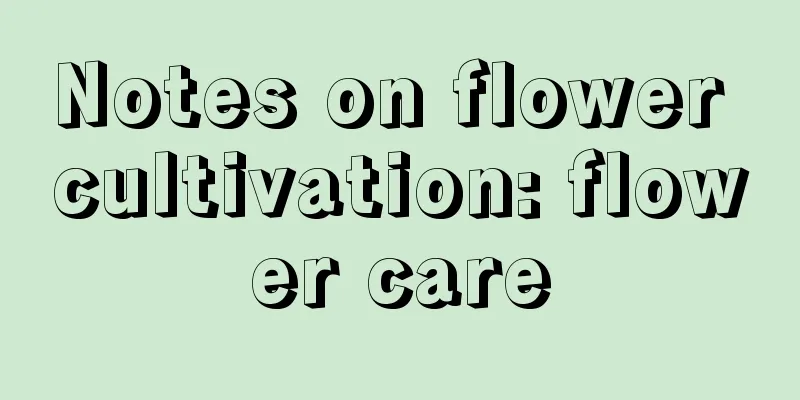Notes on flower cultivation: flower care

Summer and winterThe suitable growth temperature for most flowers is 15-25℃. If the temperature exceeds 40℃ or is lower than the minimum temperature that different flowers can tolerate, the flowers will be harmed. Safe summerThe high temperature and strong sunlight in summer often make some temperate plants unable to adapt to the heat and make some shade plants susceptible to sunburn. Therefore, when growing flowers at home, you can use methods such as shading, ventilation, spraying water, and adjusting the position of potted flowers to improve environmental impacts, lower the temperature, and allow flowers to safely survive the summer. Safe winteringFrost and freezing damage in winter have a great impact on the growth of flowers. Some flowers that are not cold-resistant will die due to frost. In autumn, plants are still in the growing season, and some flowers will suffer damage to their leaves and buds once the first frost occurs. In spring, after dormancy, plants begin to sprout and release leaves. If they are hit by late frost at this time, the damage will be very serious. During the Frost Descent period, flowers that are easily damaged can be protected by covering them with soil or film in garden cultivation. Potted flowers on the balcony can be protected by a plastic shed built against the south wall. When it is very cold in the evening, the roof and surrounding areas should be covered with woven bags or sacks to keep them warm. For balconies that have been enclosed with glass, cold-sensitive plants such as Milan, hibiscus, Christmas cactus, Impatiens, and Croton should be moved indoors and covered with transparent plastic bags to protect them over the winter. In order to increase the cold resistance of flowers and trees in winter, watering should be controlled, but water should still be added in time depending on the situation. Due to negligent management, flowers grown at home often dry out and die in winter. Pest controlWhen it comes to preventing and controlling diseases and insect pests in flower gardens at home, we should follow the principle of "prevention first". Strengthen management, improve ventilation conditions in the growing environment, do a good job in fertilizer and water management and pruning, so that flowers and trees can grow healthily, enhance their own resistance to diseases and pests, and promptly remove dead branches and leaves to prevent the spread of diseases and pests. PestsChewing pests It harms roots, stems, leaves, flowers and fruits, causing notches, perforations and holes to appear on the affected parts. Such as caterpillars, caterpillars, longhorn beetles, crab larvae (beetle larvae), etc. Use stomach poisons and contact pesticides such as diazinon, trichlorfon, pyrethroids, and phoxim. Absorption Pests Pests use their mouthparts to penetrate the plant and suck out the sap. Such as aphids, scale insects and red spiders (mites), etc., the stems and leaves damaged by them will show symptoms such as spots, shrinkage and discoloration. Use contact and systemic pesticides for control, such as dimethoate and chlorpyrifos. DiseasesFungal diseases: When attacked by fungi, mold and powdery substances can be seen growing on the host surface. Symptoms include sudden wilting, damping off, spots, scabs, mildew, and wilting. The main drugs used are carbendazim, thiophanate-methyl, and thiophanate-methyl. Bacterial diseases: Caused by bacteria, leaves develop water-soaked, translucent spots that are restricted by leaf veins. Tender organs become necrotic, slimy and smelly. The diseased stems show signs of wilting, and the vascular bundles can be seen turning brown when cut cross-sectioned. The main drugs used are: Jinggangmycin, agricultural streptomycin, etc. |
>>: Factors that affect seed germination rate
Recommend
Is the Ixora dropping leaves at home? After learning these four tricks, all problems will be solved!
1. What to do if the leaves of the Immortelle flo...
How many days does it take for vegetable seeds to germinate in winter?
How long does it take for vegetable seeds to germ...
When is the best time to harvest onions?
Green onion is a very common vegetable and a very...
How to care for the succulent plant Angel's Tears
soil Angel's Tears likes loose, breathable an...
The language and legend of coral flowers
Coral Flower The flower language of coral flower ...
Breeding methods and precautions for dwarf snow wheels
1. Maintenance methods 1. Watering: When transiti...
What are the cultivation methods and precautions of arrowroot?
Growth habits of arrowroot Arrowroot prefers warm...
How to grow garlic
1. Prepare the container First prepare a hydropon...
The past and present of Tumi, and the secrets of its variants
Tumi's Past Life Previous life in history The...
When does the rose bloom? Pictures of roses
1. When do roses bloom? 1. Flowering time General...
What is the difference between rose cuttings and grafting (the advantages of rose cuttings and grafting)
There are four methods for rose propagation: sowi...
What flowers are suitable for growing in Heihe? What are the city flowers and trees?
1. Climate characteristics of Heihe Heihe City is...
5 ways to propagate green radish, one of which can make it climb all over the wall
Method 1 of cuttings of green radish Prepare the ...
When and how to plant pear trees
Pear tree planting time Pear trees are generally ...
How to graft miniature roses (what miniature roses to use for grafting rose bonsai)
How to graft miniature roses Today I bought 60 ro...









